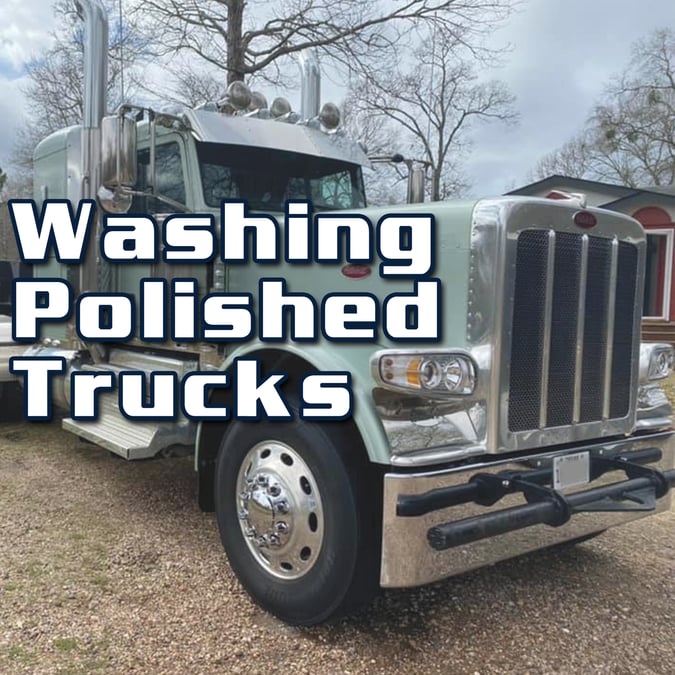Having aluminum surfaces on your fleet can be beneficial for many reasons. Not only do they require repairs less often, they are also lighter than its alternatives. In fact, aluminum truck beds are typically 40% lighter than steel truck beds that have the same strength. While aluminum truck surfaces do require less maintenance, they are often more expensive to buy. This means that you will need to know how to properly care for these aluminum surfaces to protect your investment.
Aluminum parts on your fleet can attract road film and other contaminants causing them to dull over time. Unless cleaned regularly, this will create the need to replace your fleet more often and keep your fleet off the road for longer periods of time.
No matter what industry you are in, we know how important it is to keep your fleet moving. In this blog we will discuss how to properly care for your polished truck surfaces that will get them back on the road quicker and cleaner.
How to Maintain Polished Aluminum
Bare aluminum surfaces on semis will include your wheels, fuel tanks, exhaust stacks, bumpers, grills, step plates, air cleaners, and trim. Besides having aluminum wheels and trim, many types of trailers such as fuel tankers, grain haulers, and dry van/box trucks may also be composed solely of aluminum.
In its natural state, aluminum has a satin-silver appearance. However, for a richer mirror appearance, aluminum can be polished in a more detailed process. Many owner/operators, small fleet owners, and brand new fleet vehicles may have this polished aluminum appearance which requires a special cleaning process to maintain along with regular detailing. It's important to know if the surface you're washing is polished aluminum or just 'shiny' metal and how to tell the difference.
Even with regular washing using polish safe detergents and the proper cleaning process, polished aluminum will eventually fade to a more satin-like appearance due to oxidation and corrosion caused by road film.
How to Clean Polished Aluminum
Cleaning polished aluminum requires specialty detergents and, in many cases, a more detailed process than a standard fleet wash. To best maintain the mirror finish of polished aluminum, we recommend weekly or even more frequent washings.
Begin your cleaning process with your pretreatment. You will start this by applying a polish-safe bug remover or polish-safe degreaser to heavily soiled surfaces. You could also pre-rinse areas that may be full of mud, film, and debris.
After your pretreatment, you can start to apply your detergents. To apply those detergents, start from the bottom to the top in an overlapping motion. This ensures complete coverage and more even pressure during application.
If performing a 2-step cleaning process, begin with your polish-safe low pH presoak followed by the polish-safe high pH alkaline soap. At this time, you may need to brush/agitate heavier areas of film prior to rinsing. Allow to dwell long enough to create a cleaning reaction, but be sure to rinse and work in sections to prevent the detergents from drying.
If you are using a 1-step cleaning process or fully brush washing, follow the same steps and use the same precautions to ensure detergents are applied evenly with equal pressure and not allowed to dry before rinsed.
Final Rinse and Post Treatment
Once you have applied your detergents and performed your cleaning process, your final rinse will remove all of the soap residue and road film. Start your rinse from the top to the bottom to ensure equal pressure and complete removal of residue to remove it from your freshly cleaned surface.
If you are cleaning with water containing grains of hardness and higher total dissolved solids (TDS), you may need to perform an additional post-treatment. Vehicles with polished metal surfaces, glass, and darker paint colors are more likely to show spots/streaking caused by water.
If facing this issue, follow these methods:
-
Perform a final rinse using spot-free water from a reverse osmosis (RO) or de-ionizing (DI) filtration process. This creates a sheet-drying effect that removes water spots and cleaning residue for a brighter spot-free result.
-
Perform a final rinse using water treated with a small dilution of Hydro-Sheen. This is Hydro-Chem Systems' version of a spray wax/rinsing aid, that will somewhat mimic the effects of using spot-free water and can reduce the amount of water spots while also leaving a protective hydro-phobic barrier on the vehicle surface.
-
Hand dry using a fine tarry cloth or chamois to remove water residue carefully without causing abrasions to the polished/painted surfaces.
-
Use a drying system such as blow-dryers in a larger automated vehicle wash system or even a hand-held leaf blower for smaller scale purposes.
Final Step
Now that we’ve gone over the importance of keeping your aluminum surfaces clean and polished, you will want to keep these steps as your playbook for proper maintenance. Keeping your fleet on a regular cleaning schedule can be time consuming, which is why Hydro-Chem Systems has a complete line of polished, safe 1-step and 2-step detergents, along with specialty products for degreasing, bug removal, and any other contaminants that require removal. We will even deliver these detergents right to you!
Consult with your detergent account specialist or distributor for more information.


